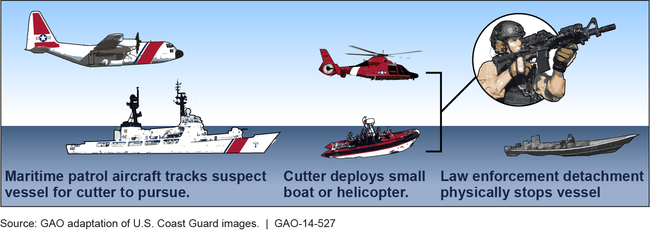Coast Guard: Resources Provided for Drug Interdiction Operations in the Transit Zone, Puerto Rico, and the U.S. Virgin Islands
Highlights
What GAO Found
The Coast Guard provided varying levels of resources for drug interdiction operations in the “transit zone”—the area from South America through the Caribbean Sea and the eastern Pacific Ocean that is used to transport illicit drugs to the United States—during fiscal years 2009 through 2013, and generally did not meet its performance targets for several reasons. As the figure shows, Coast Guard resources included vessels (cutters), aircraft, and law enforcement detachments. The number of cutter days, aircraft hours, and law enforcement detachment days the Coast Guard provided for drug interdiction operations in the transit zone varied during fiscal years 2009 through 2012, and then sharply declined in fiscal year 2013. For example, in fiscal year 2012, the Coast Guard provided 1,947 cutter days for transit zone operations and in fiscal year 2013 the Coast Guard provided 1,346 days—a 30 percent decline. During fiscal years 2009 through 2013, the Coast Guard met targets for its primary drug interdiction mission performance measure—the removal rate of cocaine from noncommercial vessels in the transit zone—once, in fiscal year 2013. Coast Guard officials cited the declining readiness of its aging vessels, delays in the delivery of replacement vessels, and sequestration as factors affecting Coast Guard resource deployments and the ability to meet its drug interdiction mission performance targets.
Coast Guard Resources Used to Support Drug Interdiction Operations

In support of a Department of Homeland Security (DHS) effort to address the increased violent crime associated with illicit drug smuggling into Puerto Rico and the U.S. Virgin Islands, the Coast Guard has increased vessel and aircraft operations for drug interdiction efforts in these territories by reallocating resources from elsewhere in the Coast Guard. According to Coast Guard officials, these additional resources are drawn from other missions, such as alien migrant interdiction. Beginning in September 2012, the Coast Guard implemented a surge operation to provide additional vessels and aircraft to regularly patrol Puerto Rico and the U.S. Virgin Islands. According to Coast Guard officials, the increased vessel and aircraft deployments have since become the new baseline level of resources to be provided for drug interdiction operations there. According to Coast Guard data, the number of vessel hours spent conducting drug interdiction operations in these territories more than tripled from fiscal years 2009 through 2013. Similarly, the number of maritime patrol aircraft hours spent conducting drug interdiction operations in the territories increased—from about 150 flight hours in fiscal year 2011 to about 1,000 hours in fiscal year 2013.
Why GAO Did This Study
One part of the U.S. National Drug Control Strategy is to disrupt the flow of cocaine through the transit zone. Puerto Rico and the U.S. Virgin Islands, the only U.S. territories located geographically within the transit zone, have served as entry points for cocaine destined for the continental United States. In recent years, federal and local government agencies have cited growing levels of violent crime in these territories and attribute this violence to illicit drug trafficking. Within DHS, the U.S. Coast Guard is the lead federal agency for maritime drug interdiction and a key provider of resources to support drug interdiction operations in the transit zone and the two territories.
GAO was asked to examine the Coast Guard's drug interdiction efforts in the transit zone, Puerto Rico, and the U.S. Virgin Islands. This report addresses (1) trends in the Coast Guard's deployment of resources in the transit zone and the extent to which the Coast Guard met its performance targets; and (2) actions taken by the Coast Guard to combat drug smuggling into Puerto Rico and the U.S. Virgin Islands, and trends in vessel and aircraft deployments. GAO analyzed Coast Guard data for fiscal years 2009 through 2013 on drug interdiction resource deployments and mission performance, and interviewed Coast Guard and DHS officials involved in drug interdiction operations.
Recommendations
GAO is not making recommendations in this report. DHS provided technical comments on a draft of this report, which were incorporated, as appropriate.
